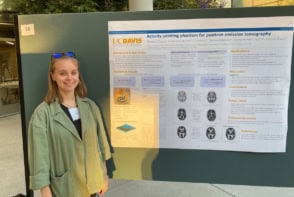A round-up of the latest international patent applications in radiation therapy.
MRI/PET-guided system verifies dose-deposition
Researchers from Alberta Health Services have designed an MRI/PET-guided radiotherapy system that can determine the in vivo dose deposition of a treatment beam in real time (WO/2018/023195). The system includes a bi-planar MRI apparatus that comprises a pair of spaced apart magnets, one of which has a hole in the centre. A radiotherapy source is configured to generate a treatment beam and transmit it through the hole in the magnet. A patient support positions the patient within the system such that the treatment target is proximal to the radiotherapy beam. A PET detector, configured to obtain PET data from the beam impacting the patient, is positioned such that a transverse section of the patient including the treatment target lies between opposing portions of the detector.
Treatment planning system exploits machine learning
Elekta has published details of systems and methods for developing radiotherapy treatment plans via machine learning approaches and neural network components (WO/2018/048575). A neural network is trained using one or more 3D medical images, one or more 3D anatomy maps and one or more dose distributions, to predict a fluence or dose map. During training, the neural network receives a predicted dose distribution that is compared to an expected dose distribution. The comparison is performed iteratively until a predetermined threshold is achieved. The trained neural network is then utilized to provide a 3D dose distribution.
HIFU ablates large volumes, protects critical structures
SonaCare Medical has developed a method for delivering high-intensity focused ultrasound (HIFU) to large tissue volumes while protecting critical structures (WO/2018/057580). The approach includes positioning at least one focal zone of a transducer in an ultrasound probe proximate to the targeted tissue. The transducer delivers ultrasound energy to a portion of the tissue for a predetermined time to create an initial focal lesion(s). Next, the transducer delivers ultrasound to the targeted tissue continuously and along a predefined treatment path. The first lesion(s) can act as a barrier for subsequent HIFU ablation of tissue located beyond or behind it, thereby protecting this tissue from unintended ablation.
Phantoms offer QA for biologically-guided radiotherapy
RefleXion Medical has created phantoms for calibration and quality assurance of radiation therapy systems, including biologically-guided systems that deliver dose in response to real-time detected PET lines-of-response (WO/2018/081420). The modular phantoms comprise a cylindrical housing with a number of disks stacked within the housing and a number of radiographic films between the disks. The disks may comprise a positron-emitting material. Some disks have a background region and a target region (with a higher level of PET activity) of any desired cross-sectional shape. The disks may be arranged within the housing such that regions of higher PET activity are aligned to simulate the shape of a tumour in the patient.
Ultrasound takes control of neuromodulation
Neuromodulation, using electrical stimulation of the central nervous system, for example, is used to treat a variety of clinical conditions. However, positioning electrodes at or near the target nerves is challenging, as is specific tissue targeting. A team from GE and the Feinstein Institute for Medical Research has published details of techniques for neuromodulation of tissue via application of ultrasound energy into the tissue (WO/2018/081826). This energy causes altered activity at a synapse between a neuron and a non-neuronal cell, in order to achieve a targeted physiological outcome.



